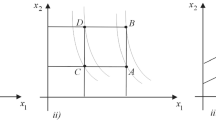Abstract
The risk premium (conveniently normalized) is defined as the measure of risk aversion. This measure does not require any relevant assumption in the theory of choice under uncertainty except the existence of a certainty equivalent. In particular, the independence axiom is not required. The measure of risk aversion of an action is provided not only for the case with one commodity and two consequences but also for the case with many commodities and consequences. The measure of mean risk aversion of all actions with given consequences is introduced and the local measure of risk aversion is obtained by making all these consequences approach the consequence under consideration. This measure is demonstrated to be zero when the von Neumann-Morgenstern utility function exists. In this case a measure of risk aversion of the second order is introduced, which turns out to be equal to the Arrow-Pratt absolute index when there is only one commodity and similar to the generalized measures proposed by several authors when there are many commodities and two consequences.
Similar content being viewed by others
References
Arrow, K. J.: 1965, Aspects of the Theory of Risk Bearing, Yrjo Jahnssonian Saatio, Helsinki.
Biswas, T.: 1983, ‘A Note on the Generalized Measures of Risk Aversion’, Journal of Economic Theory 29, 347–352.
Chew, S. H., Karni, E. and Safra, Z.: 1987, ‘Risk Aversion in the Theory of Expected Utility with Rank Dependent Probabilities’, Journal of Economic Theory 42, 370–381.
Deschamps, R.: 1973, ‘Risk Aversion and Demand Functions’, Econometrica 41, 455–465.
Hanoch, G.: 1977, ‘Risk Aversion and Consumer Preferences’, Econometrica 45, 413–426.
Khilstrom, R. E. and Mirman, L. J.: 1974, ‘Risk Aversion with Many Commodities’, Journal of Economic Theory 8, 361–388.
Machina, M. J.: 1987, ‘Choice under Uncertainty: Problems Solved and Unsolved’, Economic Perspectives 1, 121–154.
Montesano, A.: 1986, ‘A Measure of Risk Aversion in Terms of Preferences’, in Daboni L., Montesano A., and Lines M. (eds.), Recent Developments in the Foundations of Utility and Risk Theory, Dordrecht, Reidel, pp. 327–335.
Pratt, J. W.: 1964, ‘Risk Aversion in the Small and in the Large’, Econometrica 32, 122–136.
Quiggin, J.: 1982, ‘A Theory of Anticipated Utility’, Journal of Economic Behavior and Organization 3, 323–343.
Röell, A.: 1987, ‘Risk Aversion in Quiggin and Yaari's Rank-Order Model of Choice under Uncertainty’, Economic Journal 97, (Conference 1987), 143–159.
Rothschild, M. and Stiglitz, J. E.: 1970, ‘Increasing Risk: I. A Definition’, Journal of Economic Theory 2, 225–243.
Stiglitz, J. E.: 1969, ‘Behavior towards Risk with Many Commodities’, Econometrica 37, 660–667.
Yaari, M. E.: 1987, ‘The Dual Theory of Choice under Risk’, Econometrica 55, 95–115.
Author information
Authors and Affiliations
Additional information
Helpful comments by I. Gilboa and suggestions by the referee are gratefully acknowledged.
Rights and permissions
About this article
Cite this article
Montesano, A. The risk aversion measure without the independence axiom. Theor Decis 24, 269–288 (1988). https://doi.org/10.1007/BF00148959
Issue Date:
DOI: https://doi.org/10.1007/BF00148959



